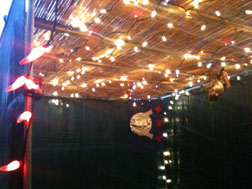 When I was a kid, I was completely fascinated with Christmas trees. I am sure this was because they were off-limits in our house —as in, “There’s no such thing as a Chanukah bush. Period.”My friends’ trees were so beautiful, however, that they were hard to resist. The lights, the glass ornaments, the miniature animals and nutcrackers; it’s just too much. So as a teen, I used to get myself invited to my non-Jewish friends’ houses to help them put up the tree.
When I was a kid, I was completely fascinated with Christmas trees. I am sure this was because they were off-limits in our house —as in, “There’s no such thing as a Chanukah bush. Period.”My friends’ trees were so beautiful, however, that they were hard to resist. The lights, the glass ornaments, the miniature animals and nutcrackers; it’s just too much. So as a teen, I used to get myself invited to my non-Jewish friends’ houses to help them put up the tree.
My best friend thought I was nuts. She wanted to get out of putting up the tree, not become more enmeshed. To her it had become an annoying family chore. But there I was, elbow-deep in ribbons and glitter with her mother, baking bread-dough ornaments to hang on the tree. I’d go over another friend’s house and marvel that they could have two trees: one for the handmade ornaments and another to be done up in just silver balls and mirrors. “Let me help,” was out of my mouth before I could even think about it.
In college, I didn’t exactly cringe or shout, “Not on my watch!” when my non-Jewish suitemates wanted a tree. There I was again with the ubiquitous bread dough, making ornaments to represent each of us. I kind of cringe at the thought now, but no one ever said college was a time of abundant good taste.
And even working at my last job, when my co-workers bought a tree and brought it back to the office, I made tiny little photocopies of our magazine’s cover to hang in the branches. How festive!
I realized at some point that while all this decorating was fun, it left me feeling uneasy, as if I were enjoying the smell of bacon just a little too much. I needed a Jewish alternative to the Christmas tree, something to decorate that would allow me to exercise my inner Martha Stewart without feeling that I had crossed into some forbidden territory or betrayed my Jewish observance.
And of course, I found it. It was standing right in front of me, so obvious that the politest thing you can possibly say about it is, “It’s the sukkah, dummy.”
When we moved from the city to the suburbs eight years ago, I wasn’t quite ready for the whole house and yard thing. But to sweeten the deal, I demanded the only thing I could think of as adequate recompense. A sukkah.
We had a yard, and I was going to use it. Each year my husband would build the sukkah from scratch, and the kids and I would go scrambling for schach, the branches or long grasses to put on top. The tarps we used were a bit unwieldy, and sometimes the whole structure leaned a bit, but it was a real sukkah in our yard. And we got to decorate it, and of course, eat in it, our final outdoor meals of the year before the autumn chill set in.
A few years ago, tired of the Leaning Tower of Sukkah, we capitulated and bought a kit online from the Sukkah Project in North Carolina. No more lean-tos for us. It takes all of 30 minutes to assemble, and the green fabric on the sides never bunches.
You’d think after all my fuss about the Christmas tree, I’d be raring to go with the works. Little handmade fruits, tinsel, drawings of ushpizim (our ancestors), you name it. Twinkly lights, and other things that glint and shine.
And yet, the sukkah is different.
Oh sure, we decorate it. The kids make paper chains. Our friends from the city, who always come up for a Shabbat in the sukkah, usually bring some sort of “harvest ornament.” We hang all the yontif cards from the bamboo roof, dangling by satin ribbon. Last year, the kids and I spent a couple of days making papier m�ché pomegranates. And as a nod to my Texas roots, my mom sent a strand of chili pepper lights to frame the doorway.
But it is, most important, not a Christmas tree, even though it shares with that winter canvas its temporary nature. In the Torah, God commands us to live in the sukkah for seven days. The booths are vestiges of a harvest culture, when we celebrated the gathering of the fall crops. The sukkah reminds us of our ever-wandering status, as we forever wend our way to Jerusalem.
The sukkah in our yard is simply that — with its view of the open sky and the hokiness of our décor. I enjoy decorating it each year. To me, nothing else feels quite like autumn as setting the Shabbat table and hoping the little squash hanging from the roof won’t fall on my head.
So this year, I’m wondering as I write, should we make more pomegranates? What about papier mâché etrogs? Maybe we should laminate pictures of our grandparents, and bring them into our hut as our honored guests.
And maybe, at lunch, I’ll drive over to the Christmas Tree Shops and buy another strand of lights.
Marla Cohen, editor of the Rockland Jewish Reporter in New York, has been practicing her glue-gun and papier mâché technique all summer and is now ready to shev b’sukkah. This article was formerly published in the Rockland Jewish Reporter.
